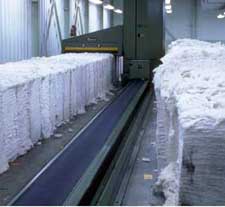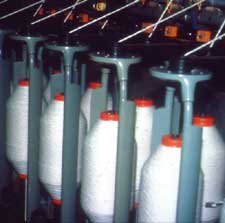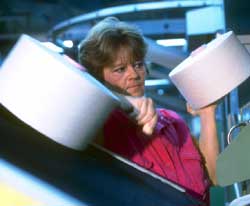Yarn Production
Yarn Production
Modernization efforts have brought major changes to the U.S. textile industry.  Equipment has been streamlined and many operations have been fully automated with computers. Machine speeds have greatly increased. Equipment has been streamlined and many operations have been fully automated with computers. Machine speeds have greatly increased.At most mills, the opening of cotton bales is fully automated. Lint from several bales is mixed and blended together to provide a uniform blend of fiber properties. To ensure that the new high-speed automated feeding equipment performs at peak efficiency and that fiber properties are consistent, computers group the bales for production/feeding according to fiber properties. The blended lint is blown by air from the feeder through chutes to cleaning and carding machines that separate and align the fibers into a thin web. Carding machines can process cotton in excess of 100 pounds per hour. The web of fibers at the front of the card is then drawn through a funnel-shaped device called a trumpet, providing a soft, rope-like strand called a sliver (pronounced SLY-ver). As many as eight strands of sliver are blended together in the drawing process. Drawing speeds have increased tremendously over the past few years and now can exceed 1,500 feet per minute. Roving frames draw or draft the slivers out even more thinly and add a gentle twist as the first step in ring spinning of yarn.  Ring spinning machines further draw the roving and add twist making it tighter and thinner until it reaches the yarn thickness or “count” needed for weaving or knitting fabric. The yarns can be twisted many times per inch. Ring spinning machines further draw the roving and add twist making it tighter and thinner until it reaches the yarn thickness or “count” needed for weaving or knitting fabric. The yarns can be twisted many times per inch.Ring-spinning frames continue to play a role in this country, but open-end spinning, with rotors that can spin five to six times as fast as a ring-spinning machine, are becoming more widespread. In open-end spinning, yarn is produced directly from sliver. The roving process is eliminated. Other spinning systems have also eliminated the need for roving, as well as addressing the key limitation of both ring and open-end spinning, which is mechanical twisting. These systems, air jet and Vortex, use compressed air currents to stabilize the yarn. By removing the mechanical twisting methods, air jet and Vortex are faster and more productive than any other short-staple spinning system.  After spinning, the yarns are tightly wound around bobbins or tubes and are ready for fabric forming. Ply yarns are two or more single yarns twisted together. The cord is plied yarn twisted together. After spinning, the yarns are tightly wound around bobbins or tubes and are ready for fabric forming. Ply yarns are two or more single yarns twisted together. The cord is plied yarn twisted together. |
Materials
Yarn can be made from a number of natural or synthetic fibers. Many types of yarn are made differently though. There are two main types of yarn: spun and filament.

Fibers
The most common plant fiber is cotton, which is typically spun into fine yarn for mechanical weaving or knitting into cloth.
Cotton and polyester are the most commonly spun fibers in the world. Cotton is grown throughout the world, harvested, ginned, and prepared for yarn spinning. Polyester is extruded from polymers derived from natural gas and oil. Synthetic fibers are generally extruded in continuous strands of gel-state materials. These strands are drawn (stretched), annealed (hardened), and cured to obtain properties desirable for later processing.

Synthetic fibers come in three basic forms: staple, tow, and filament. The staple is cut fibers, generally sold in lengths up to 120mm. A tow is a continuous "rope" of fibers consisting of many filaments loosely joined side-to-side. A filament is a continuous strand consisting of anything from 1 filament to many. Synthetic fiber is most often measured in a weight per linear measurement basis, along with cut length. Denier and Dtex are the most common weight-to-length measures. Cut length only applies to staple fiber.
Filament extrusion is sometimes referred to as "spinning" but most people equate spinning with spun yarn production.
The most commonly spun animal fiber is wool harvested from sheep. For hand knitting and hobby knitting, thick, wool and acrylic yarns are frequently used.
Fiber:- A unit of matter characterized by flexible, fineness, elasticity, sufficient strength, and a high length-to-width ratio.
e.g: Natural (Cotton, Jute, Wool, Silk)
Manmade (Viscose, Polyester)
Yarn:- Yarns are a grouping of fibers twisted together to form a continuous strand.
e.g.: Staple or filament yarn.
Spinning:- Spinning is the process by which fibers are converted into yarn.







No comments